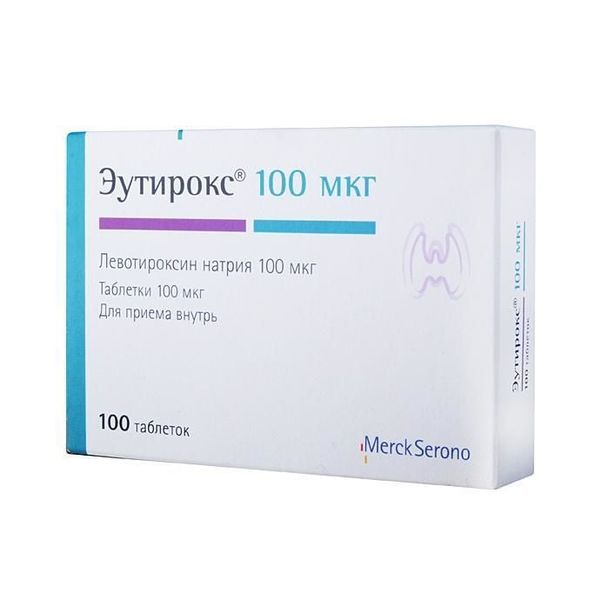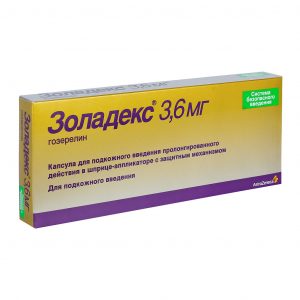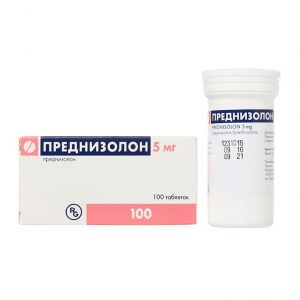Description
Latin name
EUTHYROX
Release form
White tablets, round, flat on both sides, with a bevel. On both sides of the tablet there is a dividing risk, on one side of the tablet is an EM engraving + dosage.
Packing
25 pcs. – blisters (4) – packs of cardboard.
Pharmacological action
The preparation of thyroid hormones. Synthetic levorotatory isomer of thyroxine. After partial conversion to triiodothyronine (in the liver and kidneys) and transition to body cells, it affects the development and growth of tissues, and metabolism. In small doses, it has an anabolic effect on protein and fat metabolism. In medium doses, it stimulates growth and development, increases the need for tissue in oxygen, stimulates the metabolism of proteins, fats and carbohydrates, increases the functional activity of the cardiovascular system and central nervous system. In large doses, the production of thyrotropin-releasing hormone of the hypothalamus and thyroid-stimulating hormone of the pituitary gland inhibits.
The therapeutic effect is observed after 7-12 days, during the same time the effect persists after discontinuation of the drug. The clinical effect of hypothyroidism manifests itself in 3-5 days. Diffuse goiter decreases or disappears within 3-6 months.
Pharmacokinetics
Absorption and distribution of
When taken orally, levothyroxine sodium is absorbed mainly in the upper small intestine. Absorbed up to 80% of the dose taken. Eating reduces the absorption of levothyroxine sodium.
Cmax in serum is achieved approximately 5-6 hours after ingestion.
More than 99% of the absorbed preparation binds to serum proteins (thyroxin-binding globulin, thyroxin-binding prealbumin and albumin).
Metabolism and excretion of
Monodiodination of approximately 80% of levothyroxine with the formation of triiodothyronine (T3) and inactive products occurs in various tissues. Thyroid hormones are metabolized mainly in the liver, kidneys, brain and muscles. A small amount of the drug is subjected to deamination and decarboxylation, as well as conjugation with sulfuric and glucuronic acids (in the liver). Metabolites are excreted by the kidneys and through the intestines.
T1 / 2 is 6-7 days.
Pharmacokinetics in special clinical cases
With thyrotoxicosis, T1 / 2 shortens up to 3-4 days, and with hypothyroidism it lengthens up to 9-10 days.
Indications
Hypothyroidism
euthyroid goiter
as a replacement therapy and for the prevention of goiter recurrence after resection of the thyroid gland
thyroid cancer (after surgical treatment)
diffuse toxic goiter after reaching euthyroid therapy or in combination therapy as a diagnostic tool during the thyroid suppression test.
Contraindications
Hypersensitivity to the drug
untreated thyrotoxicosis
untreated pituitary insufficiency
untreated adrenal insufficiency
use in pregnancy in combination with antithyroid drugs.
You should not start treatment for acute myocardial infarction, acute myocarditis, acute pancreatitis.
Not recommended for patients with rare hereditary diseases associated with galactose intolerance, lactase deficiency or glucose-galactose malabsorption syndrome (due to the presence of lactose in the preparation).
With caution, a drug should be prescribed for ischemic heart disease (atherosclerosis, angina pectoris, a history of myocardial infarction), arterial hypertension, arrhythmia, and diabetes mellitus, with severe long-term hypothyroidism, malabsorption syndrome (dose adjustment may be required).
Use during pregnancy and lactation
During pregnancy and during breastfeeding, therapy with the drug prescribed for hypothyroidism should continue. During pregnancy, an increase in the dose of the drug may be required due to an increase in the level of thyroxin-binding globulin.
There is no evidence of teratogenic and fetotoxic effects when using the drug in recommended therapeutic doses. The use of the drug during pregnancy in excessively high doses can adversely affect the fetus and postnatal development.
The use of the drug in pregnancy in combination with thyreostatics is contraindicated, because taking levothyroxine sodium may require increasing doses of thyreostatics. Since thyreostatics, unlike sodium levothyroxine, can penetrate the placental barrier, the fetus may develop hypothyroidism.
During the period of breastfeeding, the drug should be taken strictly as recommended.doses under medical supervision. When using the drug in recommended therapeutic doses, the concentration of thyroid hormone secreted with breast milk is insufficient to cause hyperthyroidism and suppression of TSH secretion in the child.
Composition
1 tab. contains:
Active substances: levothyroxine sodium – 100 mcg
Excipients: corn starch – 25.00 mg, gelatin – 5.00 mg, croscarmellose sodium – 3.50 mg, magnesium stearate – 0.50 mg, lactose monohydrate – 65.90 mg.
Side effects
With the correct use of the drug Eutiroks ® under the supervision of a physician, no side effects are observed.
With hypersensitivity to the drug, allergic reactions can be observed.
Drug Interaction
The use of tricyclic antidepressants with levothyroxine sodium can enhance the action of antidepressants.
Sodium levothyroxine reduces the action of cardiac glycosides.
When colestyramine and colestipol (ion exchange resins) are used simultaneously, as well as aluminum hydroxide reduce the plasma concentration of sodium levothyroxine by inhibiting its absorption in the intestine. In this regard, levothyroxine sodium should be used 4-5 h before taking these drugs.
When used with anabolic steroids, asparaginase, tamoxifen, pharmacokinetic interaction at the level of plasma protein binding is possible.
Protease inhibitors (eg, ritonavir, indinavir, lopinavir) may affect the effectiveness of sodium levothyroxine. Thorough monitoring of thyroid hormone concentrations is recommended. If necessary, adjust the dose of levothyroxine sodium.
Phenytoin can affect the effectiveness of sodium levothyroxine due to the displacement of levothyroxine sodium from plasma proteins, which can lead to an increase in the concentration of free T4 and T3. On the other hand, phenytoin increases the intensity of levothyroxine sodium metabolism in the liver. Thorough monitoring of thyroid hormone concentrations is recommended.
Sodium levothyroxine may help reduce the effectiveness of hypoglycemic drugs. Therefore, frequent monitoring of blood glucose is required since the start of thyroid hormone replacement therapy. If necessary, the dose of hypoglycemic drug should be adjusted.
Sodium levothyroxine may potentiate the effect of anticoagulants (coumarin derivatives) by ousting them from the plasma proteins due to
, which may increase the risk of bleeding, such as CNS hemorrhage or gastrointestinal bleeding, especially in patients with flushing. Therefore, regular monitoring of coagulation parameters both at the beginning and during combination therapy with these drugs is necessary. If necessary, the dose of anticoagulant should be adjusted.
Salicylates, dicoumarol, furosemide in high doses (250 mg), clofibrate and other drugs can displace sodium levothyroxine due to plasma proteins, which increases the concentration of the free T4 fraction.
Sevelamer may reduce levothyroxine sodium absorption. Tyrosine kinase inhibitors (eg, imatinib, sunitinib) may reduce the effectiveness of sodium levothyroxine. Therefore, monitoring of changes in thyroid function in patients is recommended at the beginning or end of concomitant therapy with these drugs. If necessary, the dose of sodium levothyroxine is adjusted.
Aluminum Medicines (Antacids, sucralfate), iron-containing drugs,
calcium carbonate have been described in the literature as potentially reducing the effectiveness of levothyroxine sodium. Therefore, it is recommended that levothyroxine sodium be administered at least 2 hours before the use of such drugs.
Somatropin when used concomitantly with levothyroxine sodium can accelerate the closure of epiphyseal growth zones.
Propylthiouracil, GCS, beta sympatholytics, iodine-containing contrast agents, amiodarone inhibit the peripheral conversion of T4 to T3. Due to the high content of iodine, the use of amiodarone may be accompanied by the development of both hyperthyroidism and hypothyroidism. Particular attention should be paid to the nodular goiter with the possible development of unrecognized functional autonomy.
Sertraline, chloroquine / proguanil reduce the effectiveness of levothyroxine sodium and increase serum TSH.
Drugs that promote induction of hepatic enzymes (eg, barbiturates, carbamazepine) may promote hepatic clearance of levothyroxine sodium.
There may be an increased need for sodium levothyroxine in women using estrogen-containing contraceptives or in postmenopausal women receiving hormone replacement therapy.
Consumption of co-containing products may help to reduce the absorption of levothyroxine sodium into the intestine. Therefore, dose adjustment may be required, especially at the beginning or after discontinuation of soy-containing products.
Overdose
A significant increase in metabolic rate is observed with an overdose of the drug. Clinical signs of hyperthyroidism may occur in the event of an overdose if the individual tolerance threshold for levothyroxine sodium is exceeded, or if the dose of the drug increases too rapidly from the start of therapy.
Symptoms characteristic of hyperthyroidism: heart rhythm disturbance, tachycardia, palpitations, angina pectoris, headache, muscle weakness and convulsions, hyperemia (especially of the skin of the face), fever, vomiting, menstrual irregularities, benign hypothyroidism insomnia, increased sweating, weight loss, diarrhea. Sudden cardiac arrest has been reported in patients who received excessively high doses of levothyroxine sodium for many years. In predisposed patients, there were isolated cases of convulsions when the individual tolerance threshold was exceeded.
Treatment: Depending on the severity of the symptoms showed a decrease in the daily dose of the drug, a break in treatment for several days, the appointment of beta-blockers. When using the drug in extremely high doses can be assigned to plasmapheresis. After the side effects have disappeared, treatment should be started with a lower dose of caution.
Storage conditions
The drug should be stored out of the reach of children, protected from light at a temperature not exceeding 25 ° C.
Expiration
3 years.
Deystvuyuschee substances
Levothyroxine sodium
Pharmacy terms
Prescription
dosage form
dosage form
tablets




